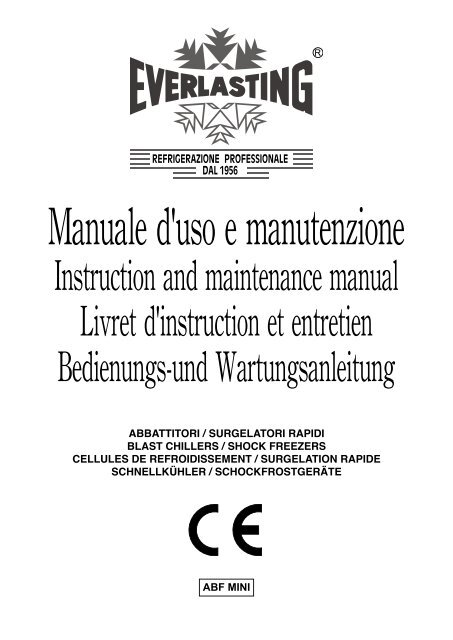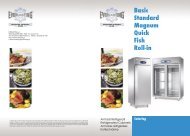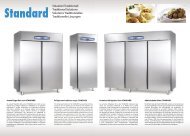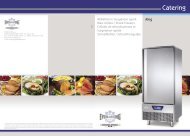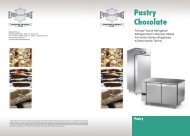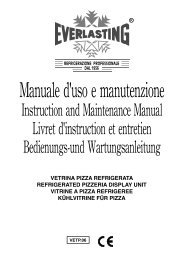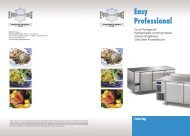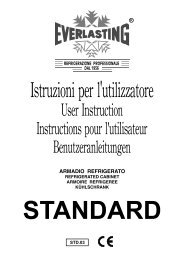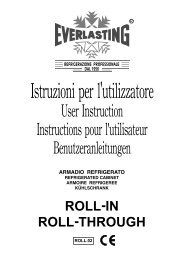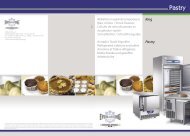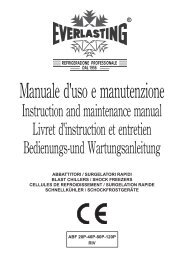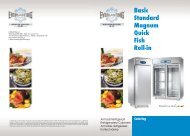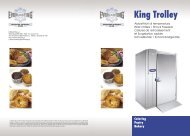MANUALE ABBATTITORI DI TEMPERATURA - Everlasting
MANUALE ABBATTITORI DI TEMPERATURA - Everlasting
MANUALE ABBATTITORI DI TEMPERATURA - Everlasting
You also want an ePaper? Increase the reach of your titles
YUMPU automatically turns print PDFs into web optimized ePapers that Google loves.
Capitolo 1 NORME ED AVVERTENZE GENERALI<br />
Section 1 STANDARDS AND GENERAL WARNINGS<br />
Chapitre 1 NORMES ET AVERTISSEMENTS GENERAUX<br />
Kap. 1 NORMEN UND ALLGEMEINE HINWEISE<br />
1.1 <strong>DI</strong>CHIARAZIONE <strong>DI</strong> CONFORMITA' - 1.1 DECLARATION OF CONFORMITY<br />
1.1 DECLARATION DE CONFORMITE - 1.1 KONFORMITÄTSERKLÄRUNG<br />
Suzzara ................................<br />
<strong>DI</strong>CHIARAZIONE CE <strong>DI</strong> CONFORMITA'<br />
CE DECLARATION OF CONFORMITY<br />
DECLARATION CE DE CONFORMITE<br />
KONFORMITÄTSERKLÄRUNG<br />
NOI - THE COMPANY - NOUS - <strong>DI</strong>E FIRMA<br />
EVERLASTING S.R.L. - Fabbrica Frigoriferi Industriali<br />
S.S. Cisa km. 161 - 46029 SUZZARA ( MN ) - ITALIA<br />
2<br />
.........................................<br />
ABF MINI<br />
Dichiariamo sotto la nostra esclusiva responsabilità che il prodotto ABBATTITORE<br />
Declares, under its own sole responsibility, that the product designated BLAST CHILLER<br />
Déclarons sous notre responsabilité exclusive que le produit CELLULE DE REFROI<strong>DI</strong>SSEMENT<br />
Erklärt unter der eigenen und ausschließlichen Verantwortung, daß das Produkt SCHNELLKÜHLER<br />
Numero di serie<br />
Serial number<br />
Numéro de série<br />
Seriennummer<br />
al quale questa dichiarazione si riferisce è conforme alle seguenti direttive europee:<br />
to which the present declaration refers, complies with the following european directives:<br />
auquel cette déclaration se rapporte, est conforme aux dispositions européennes suivantes:<br />
auf das sich diese Erklärung bezieht, den Bestimmung folgende europäische Richtlinien entsprechen:<br />
"Macchine" 2006/42/CE<br />
"Bassa tensione" 2006/95/CEE e sucessive modificazioni<br />
"Compatibilità elettromagnetica" 2004/108/CEE e sucessive modificazioni<br />
"Materiali ed oggetti destinati a venire in contatto con i prodotti alimentari" 89/109/CEE<br />
"Direttiva 97/23/CE" (PED - Pressure Equipment Directive) apparecchi in classe 1<br />
"Machines" 2006/42/CE<br />
"Low voltage" 2006/95/EEC and subsequent modifications<br />
"Electromagnetic Compatibility" 2004/108/EEC and subsequent modifications<br />
"Materials and objects designed to come into contact with foodstuff" 89/109/EEC<br />
"Directive 97/23/EC" (PED - Pressure Equipment Directive) appliances in class 1<br />
"Machines" 2006/42/CE<br />
"Basse Tensions" 2006/95/CEE et modifications successives<br />
"Compatibilité Electromagnétique" 2004/108/CEE et modifications successives<br />
"Matériels et objets destinés à entrer en contact avec des produits alimentaires" 89/109/CEE<br />
"Directive 97/23/CE" (PED - Pressure Equipment Directive) appareils en class 1<br />
"Maschinen" 2006/42/CE<br />
"Niaderspannung" 2006/95/EG und nachfolgende Änderungen<br />
"Elektromagnetische Verträglichkeit" 2004/108/EG und nachfolgende Änderungen<br />
"Zum Umgang mit Nahrungsmitteln bestimmte Materialien und Gegenstände" 89/109/EG<br />
"Richtlinie 97/23/EG" (PED - Pressure Equipment Directive) Geräte in Klasse 1<br />
La persona autorizzata a costituire il fascicolo tecnico è Paolo Guidetti, legale rappresentante della ditta<br />
EVERLASTING S.R.L. S.S. CISA KM 161 – 46029 SUZZARA (MN) – ITALIA, sede presso la quale è anche custodito.<br />
The person authorized to constitute the technical file is Paolo Guidetti, legal representative of the Company<br />
EVERLASTING S.R.L. S.S. CISA KM 161 – 46029 SUZZARA (MN) – ITALY, where the file is kept.<br />
La personne autorisée à constituer le dossier technique est Paolo Guidetti, représentant légal de la société<br />
EVERLASTING S.R.L. S.S. CISA KM 161 – 46029 SUZZARA (MN) – ITALIE, ou le dossier est conservé.<br />
Die Person die berechtigt ist die technische Unterlagen zusammenzustellen ist Paolo Guidetti, gesetzlicher Vertreter der Firma<br />
EVERLASTING S.R.L. S.S. CISA KM 161 – 46029 SUZZARA (MN) – ITALIEN, wo die Datei gehalten wird.
3<br />
ITALIANO<br />
ABF MINI<br />
1.2 COLLAUDO E GARANZIA<br />
La macchina viene collaudata presso il nostro stabilimento in ottemperanza alle norme vigenti e spedita pronta all’uso.<br />
Solo i modelli speciali Spm necessitano di un ulteriore collaudo sul posto di destinazione in quanto l'installatore deve effettuare i vari<br />
collegamenti (vedi par. 3.2 e 3.3).<br />
La garanzia ha la validità di mesi 12 dalla data di consegna della macchina, e da diritto alla riparazione o sostituzione delle parti che<br />
risultassero difettose, con esclusione delle parti elettriche ed elettroniche.<br />
I vizi apparenti e le eventuali difformità dagli ordini dovranno, sotto pena di decadenza, essere comunicati alla ditta fabbricante entro<br />
giorni 5 dal ricevimento della merce.<br />
Qualunque altro vizio (non apparente) deve essere comunicato entro giorni 5 dalla scoperta, entro comunque il periodo massimo di<br />
garanzia di mesi 6. Il committente avrà solo il diritto di richiedere la riparazione o la sostituzione della merce, con esclusione assoluta<br />
di ogni diritto al risarcimento di qualsiasi danno diretto o indiretto di qualsiasi natura. In ogni caso il diritto alla riparazione o alla<br />
sostituzione dei materiali dovrà essere esercitato nel termine massimo stabilito dalla garanzia, restando contrattualmente abbreviati<br />
i maggiori termini stabiliti dalla legge.<br />
La riparazione o la sostituzione dei materiali difettosi avverrà nello stabilimento del fabbricante, presso il quale i materiali resi dovranno<br />
essere spediti in porto franco, lo stesso provvederà a restituirli in porto assegnato.<br />
1.3 PREMESSA<br />
Questo manuale è stato redatto con lo scopo di fornire tutte le istruzioni necessarie per il corretto uso della macchina, per il mantenimento<br />
in perfetto stato della stessa ed è rivolto alla sicurezza dell’utilizzatore.<br />
E’ opportuno definire le seguenti figure professionali allo scopo di individuare i compiti e le responsabilità proprie.<br />
Installatore : tecnico qualificato che esegue il posizionamento e la messa in funzione della macchina seguendo le istruzioni contenute<br />
nel presente manuale.<br />
Utilizzatore : colui che, dopo avere preso attenta visione del manuale, utilizza la macchina per gli usi propri e consentiti.<br />
E’ responsabilità dell’utilizzatore :<br />
- conservare gli alimenti alla temperatura idonea e per i tempi consentiti<br />
- essere a conoscenza delle norme che regolano la conservazione degli alimenti e rispettare le eventuali indicazioni<br />
igieniche applicabili<br />
E’ obbligatorio, da parte dell’utilizzatore, leggere attentamente il manuale e fare sempre riferimento ad esso.<br />
In particolare si prescrive la lettura attenta e ripetuta del par. 1.5 Norme di sicurezza generali.<br />
Manutentore ordinario : tecnico qualificato in grado di effettuare degli interventi di manutenzione ordinaria sulla macchina seguendo<br />
le istruzioni contenute nel presente manuale (vedi cap. 6).<br />
Manutentore straordinario : tecnico qualificato, autorizzato dal fabbricante, in grado di effettuare degli interventi di manutenzione<br />
straordinaria sulla macchina (vedi cap. 7).<br />
In alcune parti del manuale è presente il simbolo indicante una avvertenza importante da rispettare ai fini della sicurezza.<br />
Il fabbricante declina qualsiasi responsabilità per gli usi impropri e non ragionevolmente previsti della macchina e per tutte quelle<br />
operazioni effettuate sulla stessa trascurando le indicazioni riportate sul manuale.<br />
Questo manuale deve essere custodito in luogo accessibile e noto a tutti gli operatori (installatore, utilizzatore, manutentore ordinario,<br />
manutentore straordinario).<br />
Nessuna parte di questo manuale può essere riprodotta e/o divulgata con qualsiasi mezzo e in qualsiasi forma.<br />
1.4 DESCRIZIONE DEL PRODOTTO<br />
La macchina è costituita da una monoscocca modulare rivestita con materiali diversi e isolata con poliuretano espanso a densità<br />
42 kg/m 3 .<br />
La strumentazione è raggruppata sul pannello frontale che chiude anteriormente il vano-motore nel quale può essere alloggiata l'unità<br />
condensatrice ed il cablaggio elettrico.<br />
Internamente la macchina è dotata di strutture idonee a sostenere ripiani in filo (griglie) o vassoi e contenitori Gastronorm.<br />
Le porte sono provviste di un dispositivo di ritorno automatico e di guarnizioni magnetiche.<br />
In fase di progettazione e realizzazione sono stati adottati degli accorgimenti per ottenere una macchina conforme ai requisiti di<br />
sicurezza quali gli angoli arrotondati interni, imbutiture con scarico all’esterno dei liquidi di condensa, assenza di superfici rugose,<br />
protezioni fisse su componenti mobili o pericolosi.
Abbattimento (+70° +3°C) Congelamento (+70° -18°C)<br />
kg kg<br />
ABF MINI 7 4<br />
4<br />
ITALIANO<br />
ABF MINI<br />
1.5 NORME <strong>DI</strong> SICUREZZA GENERALI<br />
Leggere attentamente il manuale ed attenersi alle prescrizioni in esso contenute.<br />
Viene demandata all’utilizzatore la responsabilità di operazioni effettuate sulla macchina trascurando le indicazioni riportate sul<br />
manuale.<br />
Di seguito sono elencate le principali norme di sicurezza generali :<br />
- non toccare la macchina avendo mani o piedi umidi o bagnati<br />
- non usare la macchina a piedi nudi<br />
- non inserire cacciaviti od altro tra le protezioni o le parti in movimento<br />
- non tirare il cavo di alimentazione per scollegare la macchina dalla rete di alimentazione elettrica<br />
- non permettere che la macchina venga usata da bambini o da utilizzatori non professionali<br />
- prima di effettuare qualsiasi operazione di pulizia o manutenzione disinserire la macchina dalla rete di alimentazione elettrica<br />
spegnendo l’interruttore generale e staccando la spina<br />
- in caso di guasto e/o di cattivo funzionamento della macchina, spegnerla ed astenersi da qualsiasi tentativo di riparazione<br />
o di intervento diretto. E’ necessario rivolgersi esclusivamente a personale qualificato.<br />
1.6 PRE<strong>DI</strong>SPOSIZIONI A CARICO DEL CLIENTE<br />
Sono a carico del cliente tutte le seguenti predisposizioni :<br />
- il collegamento elettrico della macchina<br />
- la predisposizione del luogo di installazione<br />
- i materiali di consumo per la pulizia<br />
- la manutenzione ordinaria<br />
- la predisposizione e il fissaggio in posizione remota dell'unità condensatrice in dotazione (versione speciale SPM)<br />
- la protezione adeguata delle tubazioni e dei cavi esterni alla macchina (versione speciale SPM)<br />
In caso di interruzione del circuito di alimentazione elettrica o di guasto per un tempo superiore a 15 minuti, si dovrà interrompere<br />
il ciclo di abbattimento o congelamento, in quanto vengono a mancare le condizioni di un corretto processo nei tempi stabiliti dalla<br />
normativa.<br />
1.7 ISTRUZIONI PER LA RICHIESTA <strong>DI</strong> INTERVENTI<br />
Per qualsiasi problema di carattere tecnico, e le eventuali richieste di intervento o assistenza, è necessario rivolgersi esclusivamente<br />
presso il proprio rivenditore.<br />
1.8 ISTRUZIONI PER L’OR<strong>DI</strong>NAZIONE DEI RICAMBI<br />
La richiesta delle parti a ricambio deve essere effettuata consultando l’apposito manuale delle parti di ricambio che identifica la<br />
descrizione corretta del pezzo da sostituire, il codice di riferimento ed il numero di serie che contraddistingue la macchina.<br />
L’utilizzatore deve perciò rivolgersi al proprio rivenditore.<br />
Capitolo 2 DATI TECNICI<br />
2.1 <strong>DI</strong>MENSIONI<br />
A pagina 50 sono riportate in modo schematico le viste delle macchine con le indicazioni degli ingombri .<br />
Gli ingombri delle macchine imballate in cartone, gabbia e cassa sono indicati in Tabella 1.<br />
2.2 CONFIGURAZIONI DEI PRODOTTI<br />
La macchina è destinata esclusivamente all’abbattimento di prodotti alimentari (vedi par. 4.1).<br />
I prodotti devono essere stivati rispettando i limiti di carico riportati in tabella e in Fig.1a/b - 2a/b - 3a/b - 4a/b allo scopo di assicurare<br />
una circolazione efficace dell'aria all'interno della macchina.
Evitare di sovraccaricare la macchina oltre i<br />
limiti stabiliti indicati nella tabella precedente<br />
a pagina 6 (Fig.1a - 1b)<br />
Non disporre le teglie troppo vicine l’una dall’altra<br />
onde evitare un irregolare circolo dell’aria<br />
all’interno della macchina (Fig.2a - 2b)<br />
Non posizionare le teglie troppo lontane<br />
dall’evaporatore (Fig.3a - 3b)<br />
Evitare di concentrare in un unica zona della<br />
macchina le teglie in caso il carico non sia<br />
completo ma distribuirlo in altezza in modo<br />
omogeneo (Fig.4a - 4b)<br />
2.3 POTENZA RESA E ASSORBITA<br />
I dati tecnici relativi alla potenza resa e assorbita<br />
sono rappresentati in Tabella 1.<br />
E’ necessario tenere sempre presente le<br />
caratteristiche limite di funzionamento come<br />
indicato nel par. 4.4.<br />
2.4 PESI<br />
I dati relativi al peso unitario della macchina<br />
sono rappresentati in Tabella 1.<br />
2.5 LIVELLO <strong>DI</strong> RUMOROSITA'<br />
La soglia di rumorosità della macchina rientra<br />
nelle normative di legge.<br />
2.6 MATERIALI E FLUI<strong>DI</strong> IMPIEGATI<br />
I materiali a contatto o che possono venire a<br />
contatto con i prodotti alimentari sono conformi<br />
alle direttive in materia.<br />
La macchina è stata progettata e costruita in<br />
modo tale che detti materiali possano essere<br />
puliti prima di ogni utilizzo.<br />
I fluidi frigorigeni utilizzati (R404A ) sono conformi<br />
alle disposizioni vigenti in materia.<br />
Capitolo 3 INSTALLAZIONE<br />
5<br />
ITALIANO<br />
ABF MINI<br />
3.1 TRASPORTO E MOVIMENTAZIONE<br />
Il trasporto e la movimentazione della<br />
macchina devono esclusivamente<br />
avvenire mantenendo la posizione<br />
verticale, rispettando le indicazioni poste<br />
sull’imballo.<br />
Questa precauzione è necessaria per evitare l’immissione in circolo dell’olio contenuto nel compressore che comporterebbe la rottura<br />
delle valvole, delle serpentine e problemi di avviamento del motore elettrico.<br />
Il fabbricante si esime da qualsiasi responsabilità per inconvenienti dovuti al trasporto effettuato in condizioni diverse da quelle<br />
specificate in precedenza.<br />
Gli accessori a corredo della macchina (guide, griglie, vaschette, vassoi, unità condensatrice remota con tubazioni) sono confezionati<br />
a parte e posizionati sia all’interno del mobile che nella parte esterna.<br />
La macchina è fissata su un basamento di legno e confezionata con imballi in polietilene, cartone, gabbia o cassa.<br />
Per quanto riguarda lo smaltimento dell’imballo è necessario fare riferimento al par. 3.6.<br />
La movimentazione della macchina deve essere effettuata utilizzando un carrello sollevatore o transpallets provvisto di forche idonee<br />
(lunghezza almeno pari a 2/3 del mobile) .<br />
Le dimensioni e le masse delle macchine imballate sono rappresentate in Tabella 1.<br />
I limiti di impilabilità e la posizione del baricentro sono indicati sulla targhetta dell’imballo.<br />
3.2 OPERAZIONI <strong>DI</strong> PIAZZAMENTO<br />
Poiché l’errato piazzamento della macchina può recare danno alla stessa e dar luogo a rischi per il personale, l'installatore deve<br />
rispettare le seguenti norme generali :<br />
- posizionare la macchina mantenendo una distanza minima di cm 5 da qualsiasi parete<br />
- l'ambiente deve essere sufficientemente aerato<br />
- posizionare la macchina lontano da fonti di calore<br />
- evitare l'esposizione solare diretta
Operazioni specifiche di piazzamento<br />
6<br />
ITALIANO<br />
ABF MINI<br />
- rimuovere l’imballo (polietilene-cartone-cassa-gabbia)<br />
Il polietilene è pericoloso per i bambini<br />
- rimuovere gli accessori a corredo<br />
- rimuovere il basamento in legno: con l'ausilio del martello schiodare il listello posteriore blocca piedini, inclinare lateralmente l'armadio<br />
e svitare le 2 viti autofilettanti (Fig. 5), trascinare l'armadio dalla parte posteriore tenendo fermo il basamento fino all'uscita dei 4 piedi<br />
dagli appositi spazi di contenimento, inclinare leggermente l'armadio all'indietro e rimuovere il basamento dalla parte anteriore.<br />
-utilizzare guanti di protezione nel maneggiare l’imballo in legno e il basamento in legno. La presenza di schegge potrebbe causare<br />
danni alle mani<br />
- posizionare la macchina utilizzando una livella con eventuale regolazione dei piedini del basamento metallico (Fig. 6)<br />
- rimuovere la pellicola in P.V.C. applicata come protezione alle superfici esterne della macchina<br />
- posizionare le guide porta-griglie negli appositi fori delle cremagliere (Fig. 7)<br />
- inserire la vaschetta raccogli-acqua di condensa nelle apposite guide già fissate sotto la macchina. Nel modello ABF 03 l’evaporazione<br />
dell’acqua è automatica.<br />
3.2.1 Abbattitori Spm (Fig.8)<br />
- posizionare la macchina come descritto sopra (Fig. 5-6-7)<br />
-N.B: l’impianto viene pressurizzato dal fabbricante con fluido<br />
frigorigeno<br />
- predisporre i due tubi che fuoriescono dalla macchina per l’allacciamento<br />
alle rispettive tubazioni<br />
-collegare le tubazioni dell’unità condensatrice alle tubazioni della<br />
macchina<br />
- effettuare il vuoto e successivamente la carica di fluido frigorigeno<br />
-effettuare il collegamento elettrico dalla macchina all'unità<br />
condensatrice<br />
3.3 CABLAGGIO E ALLACCIAMENTO ELETTRICO<br />
L’impianto e l’allacciamento elettrico devono essere eseguiti da<br />
personale qualificato<br />
Ai fini della sicurezza è necessario attenersi alle seguenti<br />
indicazioni:<br />
-verificare che il dimensionamento dell’impianto sia adeguato<br />
alla potenza assorbita dalla macchina<br />
-in caso di incompatibilità tra la presa e la spina della macchina,<br />
sostituire la presa con altra di tipo adatto purché a norme<br />
-non interporre adattatori e/o riduzioni (Fig. 9)<br />
E’ indispensabile collegare correttamente la macchina ad un efficace<br />
impianto di messa a terra eseguito come previsto dalle vigenti<br />
disposizioni di legge.<br />
3.4 OPERAZIONI <strong>DI</strong> MESSA A PUNTO<br />
E’ importante, per prevenire errori ed incidenti, eseguire una serie di<br />
controlli prima di avviare la macchina allo scopo di individuare eventuali danni subiti nelle operazioni di trasporto, movimentazione<br />
e allacciamento.<br />
Controlli da effettuare<br />
- verificare l’integrità del cavo di alimentazione (non deve aver subito abrasioni o tagli)<br />
- verificare la solidità dei piedini, le cerniere delle porte, i supporti dei ripiani<br />
- verificare l’integrità degli organi interni ed esterni (tubazioni, elementi radianti, ventilatori, componenti elettrici ecc.) ed il<br />
loro fissaggio<br />
- verificare che le guarnizioni delle porte non abbiano subito danni (tagli o abrasioni) e chiudano ermeticamente<br />
- verificare l’integrità delle tubazioni e dei raccordi (abbattitore SPM)<br />
Vengono fornite inoltre le indicazioni che l’utilizzatore deve seguire per ottenere le migliori condizioni di funzionamento della<br />
macchina.
Indicazioni per il funzionamento ottimale<br />
7<br />
ITALIANO<br />
ABF MINI<br />
- non ostruire le prese d’aria del vano-motore<br />
- disporre le derrate alimentari sugli appositi ripiani o contenitori. Non disporle direttamente sul fondo, né addossate alle pareti,<br />
alle porte o alle protezioni fisse (vedi Fig.1a/b - 2a/b - 3a/b - 4a/b a pag.7)<br />
- richiudere accuratamente le porte<br />
- tenere sempre sgombro il foro di scarico dell’acqua di sbrinamento<br />
- evitare l’apertura delle porte durante i cicli di abbattimento e congelamento<br />
- effettuare periodicamente la manutenzione ordinaria (vedi cap.6)<br />
3.5 REINSTALLAZIONE<br />
E’ necessario rispettare la seguente procedura :<br />
- spegnere la macchina mediante interruttore generale<br />
- scollegare il cavo di alimentazione dalla presa di corrente<br />
- la movimentazione va effettuata come descritto nel par. 3.1<br />
- per il nuovo piazzamento e allacciamento si rinvia ai par. 3.2 e 3.3<br />
3.6 DEMOLIZIONE E SMALTIMENTO<br />
La demolizione e lo smaltimento devono essere effettuati in ottemperanza alle normative vigenti nel proprio Paese.<br />
Capitolo 4 FUNZIONAMENTO<br />
4.1 APPLICAZIONI E DESTINAZIONE D’USO<br />
4.1.1 Destinazione d’uso, uso previsto e consentito<br />
La macchina è stata progettata e realizzata per il trattamento dei prodotti alimentari, quale l’abbattimento, il congelamento e la<br />
conservazione in ambito commerciale.<br />
4.1.2 Uso improprio e non consentito<br />
1) il trattamento di prodotti che necessitano di controlli continui, segnalazioni in caso di cambio di temperatura o di interruzioni della<br />
catena del freddo. A titolo di esempio si indicano :<br />
- medicinali<br />
- plasma sanguigno<br />
- reagenti chimici termosensibili<br />
2) l'utilizzo in ambienti con pericolo di esplosioni<br />
Si dichiara che ogni utilizzo al di fuori di quelli consentiti viene considerato “uso improprio” e pertanto il fabbricante ne declina ogni<br />
responsabilità.<br />
4.2 SICUREZZA ED ANTINFORTUNISTICA<br />
La macchina è stata realizzata con gli opportuni accorgimenti al fine di garantire la sicurezza e la salute dell’utilizzatore.<br />
Di seguito vengono elencate le misure adottate per la protezione contro i rischi meccanici :<br />
- superfici, spigoli, angoli : gli elementi accessibili della macchina sono privi, entro i limiti consentiti dalle loro funzioni, di angoli acuti<br />
e spigoli vivi, nonché di superfici rugose che possano causare lesioni<br />
- elementi mobili : sono stati progettati, costruiti e disposti per evitare rischi. Talune parti sono munite di protezioni fisse in modo tale<br />
da prevenire rischi di contatto che possono provocare infortuni<br />
Di seguito vengono elencate le misure adottate per la protezione contro altri rischi :<br />
- energia elettrica : la macchina è stata progettata, costruita ed equipaggiata in modo da prevenire i rischi dovuti all’energia elettrica,<br />
nel rispetto della normativa specifica vigente<br />
- rumore : la macchina è stata progettata e costruita in modo tale che i rischi dovuti all’emissione di rumore aereo siano ridotti al<br />
livello minimo possibile.<br />
4.3 <strong>DI</strong>SPOSITIVI <strong>DI</strong> SICUREZZA ADOTTATI<br />
E’ assolutamente vietato (Fig. 10):<br />
- manomettere o asportare l'involucro copri-evaporatore che protegge l’utilizzatore<br />
dal rischio di taglio delle lamelle dell’evaporatore<br />
- rimuovere le targhette applicate in basso sul retro della macchina indicanti le<br />
caratteristiche tecniche (1) e le avvertenze per il collegamento della terra (2)<br />
- rimuovere la targhetta vicino al cablaggio elettrico all'interno del vano motore, che<br />
avverte di escludere l'alimentazione prima di intervenire sull'apparecchio (3)<br />
- rimuovere le targhette, applicate all'interno del vano-motore, indicanti la messa<br />
a terra (4)<br />
- rimuovere la targhetta, applicata sul cavo di alimentazione, indicante il tipo di<br />
alimentazione (5)<br />
Il fabbricante declina qualsiasi responsabilità sulla sicurezza della macchina se<br />
questo dovesse accadere.
8<br />
ITALIANO<br />
ABF MINI<br />
4.4 CARATTERISTICHE LIMITE <strong>DI</strong> FUNZIONAMENTO<br />
La macchina è stata progettata e realizzata per poter funzionare in ambienti con temperature comprese tra i +10°C e i +32°C e umidità<br />
relativa 60% massima. In luoghi con caratteristiche diverse da quelle previste non sarà possibile ottenere le prestazioni dichiarate<br />
dal fabbricante.<br />
La tensione di alimentazione deve essere 230/240V; 50 Hz di serie.<br />
Capitolo 5 ISTRUZIONI PER L’UTILIZZATORE<br />
Le informazioni contenute in questo capitolo sono destinate all’utilizzatore oppure a personale non specializzato (vedi par. 1.3).<br />
Una volta installata, secondo le istruzioni di cui al cap. 3, la macchina è da considerare pronta all’uso.<br />
DESCRIZIONE GENERALE<br />
COSA E’ UN ABBATTITORE <strong>DI</strong> <strong>TEMPERATURA</strong>.<br />
-E’ un’apparecchiatura che abbassa velocemente la temperatura dei cibi introdotti, che essi siano freschi o preventivamente cotti.<br />
PERCHE’ UTILIZZARE UN ABBATTITORE <strong>DI</strong> <strong>TEMPERATURA</strong>.<br />
- Il cibo appena cucinato è al massimo delle sue qualità organoelettiche e di bontà, ma, se non viene servito e consumato nelle 2 ore<br />
successive, perde le iniziali caratteristiche qualitative che ne garantiscono la commestibilità.<br />
CHE COSA E’ L’ABBATTIMENTO RAPIDO A <strong>TEMPERATURA</strong> POSITIVA E IL CONGELAMENTO.<br />
- L’abbattimento rapido a temperatura positiva si esegue quando il cibo non è consumato entro le due ore successive alla sua preparazione,<br />
riducendo rapidamente, entro 90 minuti la temperatura del prodotto sino a raggiungere i tre gradi al cuore dello stesso.<br />
Il prodotto così abbattuto può essere conservato in un normale frigorifero a temperatura di 0/+3, mantenendo la propria qualità e<br />
genuinità fino a 5 giorni; ciò naturalmente senza che la catena del freddo sia interrotta. Con tecniche di confezionamento del prodotto<br />
quali il sottovuoto, il tempo di conservazione può essere allungato sensibilmente.<br />
- Il Congelamento a temperatura negativa si esegue quando si debba conservare o consumare il prodotto oltre 5 giorni dalla preparazione.<br />
L’abbattitore riduce rapidamente, entro e non oltre 4 ore la temperatura del prodotto sino a raggiungere -18 gradi al cuore dello<br />
stesso. Il prodotto così congelato deve essere poi conservato in un normale frigorifero a temperatura negativa in modo da mantenerlo<br />
ad una temperatura costante di -20 gradi e può essere consumato anche dopo 3/18 mesi, secondo il prodotto, purchè siano rispettate<br />
le norme sulla catena del freddo.<br />
ABBATTERE O CONGELARE CON UN NORMALE FRIGORIFERO.<br />
- I normali frigoriferi non hanno la potenza e la ventilazione necessaria per rimuovere in un tempo molto rapido il calore dei prodotti.<br />
Il tempo necessario sarebbe più alto di 12/20 volte e con risultati molto peggiori. Un congelamento lento trasformerebbe l’acqua<br />
contenuta nel prodotto in macrocristalli che, espandendosi, lacererebbero la struttura tissulare dell’alimento, peggiorandone le caratteristiche<br />
qualitative.<br />
5.1 DESCRIZIONE DEI COMAN<strong>DI</strong> (fig 11)<br />
5.2 Il controllore permette la gestione delle funzioni base di un<br />
abbattitore:<br />
• Abbattimento positivo o raffreddamento<br />
• Abbattimento negativo o surgelazione<br />
• Fine abbattimento con sonda al cuore o a tempo (versione PRO)<br />
• Conservazione<br />
• Sbrinamento Manuale<br />
Tramite una serie di parametri è possibile escludere alcune funzioni<br />
o cambiarne alcune.<br />
All’utente finale (cuoco) è permesso la selezione del tipo di<br />
abbattimento e l’impostazione del tempo se non è stata selezionata<br />
la sonda al cuore.<br />
5.3. Interfaccia<br />
All’avvio il controllore effettua un lamp-test di 5 secondi dopo di che si pone in Stand-by.<br />
Stand-by<br />
Visualizzazione<br />
Il display visualizza ‘---‘.<br />
Tasti<br />
Il controllore può essere attivato tramite una pressione del tasto On/Off per 4sec. Si pone in modalità Stop.
ABF MINI<br />
Stop<br />
Visualizzazione<br />
Il display visualizza il tempo (in ore e minuti) se è selezionato un ciclo a tempo oppure la lettura della sonda al cuore per un ciclo a<br />
sonda. Il punto decimale del secondo display indica la selezione di un ciclo negativo.<br />
9<br />
ITALIANO<br />
Tasti<br />
I tasti On/Off, freccia in alto, freccia in basso permettono di accedere all’impostazione del ciclo di abbattimento.<br />
La pressione di On/Off imposta automaticamente un ciclo con sonda se precedentemente era selezionato un ciclo a tempo altrimenti<br />
seleziona il set-point senza modificarlo.<br />
La pressione del tasto On/Off per 4sec. pone il controllore in Stand-by.<br />
La pressione di freccia in alto o freccia in basso imposta automaticamente un ciclo a tempo se precedentemente era selezionato un<br />
ciclo con sonda al cuore altrimenti seleziona il set-point senza modificarlo.<br />
Se è attivo il buzzer la prima pressione di freccia in basso tacita il buzzer.<br />
Una pressione semplice di Start/Stop avvia il ciclo di abbattimento.<br />
Lo sbrinamento è abilitato se P5 = 1, può essere attivato tramite una pressione di Start/Stop per per 4sec.<br />
Start<br />
Visualizzazione<br />
Il display visualizza il tempo mancante (in ore e minuti) se è selezionato un ciclo a tempo oppure la lettura della sonda al cuore per<br />
un ciclo a sonda. Il punto decimale del secondo display indica la selezione di un ciclo negativo.<br />
Se è selezionato uno sbrinamento a display compare “dEF” indipendentemente dallo stato della porta.<br />
Tasti<br />
Tenendo premuto il tasto On/Off il display visualizza il tempo trascorso dall’avvio del ciclo oppure il tempo di abbattimento se si è in<br />
conservazione.<br />
Premendo freccia in alto, viene visualizzata la temperatura letta dalla sonda camera. Tale visualizzazione permane per 5 sec.<br />
Se è attivo il buzzer, la prima pressione di freccia in basso permette di tacitare il buzzer.<br />
Una pressione semplice di Start/Stop termina il ciclo di abbattimento/conservazione.<br />
Impostazione<br />
Visualizzazione<br />
Il display visualizza il set-point selezionato (temperatura di fine abbattimento per un abbattimento con sonda al cuore, tempo di<br />
abbattimento per abbattimento a tempo). Il punto decimale del secondo display indica la selezione di un ciclo negativo.<br />
Tasti<br />
Premendo il tasto On/Off viene selezionato un ciclo con sonda se era selezionato un ciclo a tempo oppure commuta tra abbattimento<br />
positivo e negativo, e viceversa.<br />
N.B.: all’utente finale non è concesso di modificare i set-point di temperatura.<br />
La pressione di freccia in alto o freccia in basso imposta un ciclo a tempo se era selezionato un ciclo con sonda; il setpoint non è in<br />
questo caso modificato. Se era già selezionato un ciclo a tempo, freccia in alto o freccia in basso modificano tale tempo.<br />
Una pressione di Start/Stop permette di uscire dalla fase d’impostazione. È possibile uscire pure non premendo alcun tasto per 5<br />
sec.<br />
5.4. Allarmi<br />
Gli allarmi presenti sono quelli relativi alle sonde. Sono mostrati solo quando è richiesta la visualizzazione della sonda relativa.<br />
“Er “ Errore generico o interno delle sonde<br />
“Er1“ Errore sonda camera<br />
“Er2“ Errore sonda al cuore<br />
Se è in corso un abbattimento e si verifica un errore sonda al cuore, il ciclo passa a tempo pur rimanendo la visualizzazione<br />
dell’errore.
Capitolo 6 MANUTENZIONE OR<strong>DI</strong>NARIA E PROGRAMMATA<br />
10<br />
ITALIANO<br />
ABF MINI<br />
Le informazioni contenute in questo capitolo sono destinate sia all’utilizzatore, o comunque a personale non specializzato, sia al<br />
manutentore ordinario.<br />
6.1 NORME ELEMENTARI <strong>DI</strong> SICUREZZA<br />
Richiamiamo le norme elementari, di cui al par. 1.5, perché l’utilizzatore o il manutentore ordinario possano eseguire le operazioni<br />
di manutenzione ordinaria in condizioni di assoluta sicurezza :<br />
- non toccare la macchina avendo mani o piedi umidi o bagnati<br />
- non usare la macchina a piedi nudi<br />
- non inserire cacciaviti od altro tra le protezioni o le parti in movimento<br />
- non tirare il cavo di alimentazione per scollegare la macchina dalla rete di alimentazione<br />
- prima di effettuare qualsiasi operazione di pulizia o manutenzione disinserire la macchina dalla rete di alimentazione<br />
elettrica spegnendo l’interruttore generale e staccando la spina<br />
6.1.1 Proibizione della rimozione dei ripari e dei dispositivi di sicurezza<br />
E’ assolutamente vietata la rimozione delle protezioni di sicurezza per eseguire le operazioni di manutenzione ordinaria.<br />
Il fabbricante si esime da qualsiasi responsabilità per incidenti dovuti all’inadempienza del suddetto obbligo.<br />
6.1.2 Indicazioni sulle operazioni di emergenza in caso di incendio<br />
- staccare la macchina dalla presa elettrica oppure interrompere l’alimentazione generale<br />
- non utilizzare getti d’acqua<br />
- usare estintori a polvere o schiuma<br />
6.2 PULIZIA DELL’ABBATTITORE<br />
Poiché nella macchina vanno conservati dei prodotti alimentari è necessaria l’operazione di pulizia ai fini dell’igiene e della tutela<br />
della salute. La pulizia della macchina è già stata effettuata in fabbrica. Si suggerisce tuttavia di effettuare un ulteriore lavaggio delle<br />
parti interne prima dell’uso, assicurandosi che il cavo di alimentazione sia scollegato.<br />
6.2.1 Pulizia del mobile interno ed esterno<br />
Allo scopo vengono indicati<br />
- i prodotti di pulizia: acqua e detergenti neutri non abrasivi. NON USARE SOLVENTI E <strong>DI</strong>LUENTI<br />
- i metodi di pulizia: lavare con panno o spugna con prodotti idonei le parti interne ed esterne<br />
- la disinfezione: evitare sostanze che possano alterare le caratteristiche organolettiche degli alimenti<br />
- la risciacquatura: panno o spugna imbevuti d’acqua. NON USARE GETTI D’ACQUA<br />
- la frequenza: si consiglia settimanale. L’utilizzatore può’ stabilire frequenze diverse in funzione del tipo di alimenti conservati<br />
6.2.2 Pulizia del condensatore<br />
L’efficienza dell'unità condensatrice è compromessa dall’intasamento del condensatore<br />
per cui è necessario provvedere alla pulizia dello stesso con frequenza mensile.<br />
Prima di effettuare questa operazione spegnere la macchina, disinserire il cavo di<br />
alimentazione e procedere come segue :<br />
- aprire il frontale portacomandi svitando le apposite viti e facendolo ruotare sulle<br />
cerniere poste in basso.<br />
Con l’ausilio di un getto d’aria o pennello asciutto eliminare, con movimento verticale<br />
(Fig. 12), la polvere e la lanuggine depositata sulle alette.<br />
Nel caso di depositi untuosi si consiglia l’impiego di un pennello imbevuto di benzina<br />
o alcool. Ad operazione ultimata avviare nuovamente la macchina come descritto nel<br />
par. 5.1 e 5.2. (ricordandosi di richiudere prima il frontale portacomandi)<br />
Durante questa operazione usare i seguenti dispositivi di protezione individuali:<br />
occhiali, maschera di protezione delle vie respiratorie, guanti resistenti agli agenti<br />
chimici (benzine-alcool).<br />
6.3 VERIFICHE PERIO<strong>DI</strong>CHE DA ESEGUIRE<br />
Di seguito vengono elencati i punti o i gruppi della macchina che necessitano di verifiche periodiche :<br />
- integrità ed efficienza delle guarnizioni delle porte<br />
- integrità delle griglie a contatto con gli alimenti<br />
- integrità delle cerniere di fissaggio delle porte<br />
- integrità dei cavi elettrici e degli organi elettrici<br />
6.4 PRECAUZIONI IN CASO <strong>DI</strong> LUNGA INATTIVITA'<br />
Per lunga inattività si intende un periodo di fermo superiore a 15 giorni.<br />
E’ necessario procedere come segue :<br />
- spegnere la macchina e scollegarla dall’alimentazione elettrica<br />
- effettuare la pulizia accurata del mobile interno, ripiani, vassoi, guide e supporti con particolare attenzione ai punti<br />
critici quali giunzioni e guarnizioni magnetiche, secondo le indicazioni riportate al par. 6.2<br />
- lasciare le porte semiaperte per evitare il ristagno d’aria e umidità residua<br />
ALCOOL
6.5 MANUTENZIONE PREVENTIVA<br />
6.5.1 Riavvio dopo lunga inattività<br />
Il riavvio dopo lunga inattività è un evento che richiede un intervento di manutenzione preventiva.<br />
E’ necessario eseguire una accurata pulizia come descritto nel par. 6.2.<br />
11<br />
ITALIANO<br />
6.5.2 Controllo dei dispositivi di avvertimento e comando<br />
Verificare il corretto funzionamento dei vari controlli in base a quanto indicato nei par. 5.1 e 5.2.<br />
Si consiglia di richiedere al rivenditore un contratto di assistenza o manutenzione periodica che comprenda :<br />
- pulizia del condensatore<br />
- verifica della carica del fluido frigorigeno<br />
- verifica del funzionamento a ciclo completo<br />
- sicurezza elettrica<br />
Capitolo 7 MANUTENZIONE STRAOR<strong>DI</strong>NARIA E RIPARAZIONE<br />
ABF MINI<br />
Tutti gli interventi di manutenzione che non sono stati descritti nei capitoli precedenti sono da considerare “Manutenzione<br />
Straordinaria”.<br />
La manutenzione straordinaria e la riparazione sono compiti riservati esclusivamente al personale specializzato ed autorizzato dal<br />
fabbricante.<br />
Si declina ogni responsabilità per interventi condotti dall’utilizzatore, da personale non autorizzato, o per l’utilizzo di ricambi non<br />
originali.<br />
Capitolo 8 SCHEMISTICA<br />
A pagina 21 sono rappresentati gli schemi elettrici relativi alle macchine diversificati per gamma di temperatura.<br />
Gli schemi riportati sono destinati a personale specializzato addetto alla manutenzione straordinaria (vedi cap. 7).
12<br />
ENGLISH<br />
ABF MINI<br />
1.2 TESTING AND GUARANTEE<br />
The appliance is tested in our works in compliance with established regulations and then shipped ready for use.<br />
Only special models Spm require additional testing at the place of installation, because these units require a series of connections to<br />
be made by a qualified installer (see headings 3.2 and 3.3).<br />
The guarantee is valid for a full 12 months from the date of delivery of the appliance and it covers the repair or replacement of any<br />
defective parts, with the exception of electrical and electronic components.<br />
Manifest defects or differences with respect to the client’s order must be communicated to the manufacturer within five days from the<br />
receipt of the goods or they will not be covered by the guarantee terms.<br />
Any hidden or other defects must be communicated to the manufacturer within five days from the time that they are discovered and,<br />
in any event, within the maximum guarantee term of six months. The purchaser shall be entitled only to request repair or replacement<br />
of the goods. The purchaser is not entitled to claim compensation for direct or indirect damages of any whatsoever nature. In any<br />
event, the entitlement to repair or replacement of the materials must be exercised within the maximum term of the guarantee, which<br />
is contractually stipulated to cover a shorter period than the maximum term established by law.<br />
Repairs or replacement of defective materials will be carried out at the manufacturer’s works; material returned to the manufacturer<br />
must be shipped carriage paid and will be returned to the purchaser carriage forward.<br />
1.3 INTRODUCTION<br />
This manual has been prepared with the scope of supplying all the instructions required for the correct use of the appliance and to<br />
maintain it in optimal condition. It also contains important user safety information.<br />
The following professional roles are explained in order to define the responsibilities of each:<br />
Installer: a qualified technician who positions the appliance and places it in service it in accordance with the instructions in this<br />
manual.<br />
User: the person who, after having read this manual carefully, operates the appliance in accordance with the intended use specified<br />
in this manual.<br />
Users’ responsibilities:<br />
- to ensure that food products are conserved at suitable temperatures and not exceeding the permitted period of time<br />
- to be aware of the regulations governing the conservation of food and to observe any whatsoever hygiene indications<br />
that may be applicable.<br />
The user is obliged to read the manual attentively and refer to the information in the manual at all times.<br />
Particular attention must be paid to the contents of heading 1.5 General safety warnings.<br />
Routine maintenance technician: qualified technician able to perform routine maintenance of the appliance by following the instructions<br />
in this manual (see section 6).<br />
Special maintenance technician: qualified technician, authorized by the manufacturer to perform extraordinary maintenance of the<br />
appliance (see section 7).<br />
The symbol appears at certain points in the manual to draw the reader’s attention to important safety information.<br />
The manufacturer declines any whatsoever responsibility in the case of improper use of the appliance deviating from the reasonably<br />
construed intended use, and for all operations carried out that are not in compliance with the instructions laid down in the manual.<br />
This manual must be conserved in a place that is accessible and known to all operators (installer, user, routine maintenance technician,<br />
special maintenance technician).<br />
This manual must not be reproduced or divulged, in whole or in part, using any whatsoever means or in any whatsoever form.<br />
1.4 PRODUCT DESCRIPTION<br />
The appliance comprises a modular single body with panelling in various materials and insulation in expanded polyurethane foam,<br />
density 42 kg/m 3 .<br />
The appliance instruments are located on the front panel which closes the front of the motor unit, inside which the condenser unit and<br />
electrical wiring can be housed.<br />
The refrigerator interior is fitted with suitable supports for wire shelves (grids) or trays and Gastronorm containers.<br />
The doors are fitted with an automatic return device and magnetic seal elements.<br />
During the design and construction stage all measures have been adopted to implement total safety including radiused interior<br />
corners, funnel-shaped base panel to convey condensate to exterior, no rough surfaces, fixed guards protecting moving or potentially<br />
dangerous parts.
1.5 GENERAL SAFETY REGULATIONS<br />
Blast chilling (+70°+3°C) Schock freezing (+70°-18°C)<br />
kg kg<br />
ABF MINI 7 4<br />
13<br />
ENGLISH<br />
Read this manual carefully and follow the prescriptions contained herein.<br />
The user assumes full responsibility in the case of operations carried out without observing the instructions in the manual.<br />
Primary general safety regulations:<br />
ABF MINI<br />
- do not touch the unit with wet hands and/or feet<br />
- do not use the appliance with bare feet<br />
- do not insert screwdrivers or other pointed objects between guards or moving parts of the appliance<br />
- do not pull the power cord to disconnect the appliance from the electrical mains<br />
- make sure that the appliance is not used by children or unsuitably qualified persons<br />
- before performing any cleaning or maintenance on the appliance disconnect it from the electrical mains by switching of the<br />
main switch and extracting the plug<br />
- in the case of faults or malfunctions, switch off the appliance and do not attempt to repair it yourself. All service and repair<br />
operations must be performed exclusively by suitably qualified authorized technicians.<br />
1.6 CLIENT’S RESPONSIBILITIES<br />
The customer is required to:<br />
- execute the electrical connection of the appliance<br />
- prepare the place of installation<br />
- provide consumable materials for cleaning<br />
- perform routine maintenance<br />
- prepare and mount, in a remote location, the condenser unit supplied with the system (SPM special model)<br />
- Provide adequate protection for pipes and cables external to the appliance (SPM special model)<br />
In the case of power failures or malfunctions for more than 15 minutes the blast chilling or schock freezing cycle must be interrupted<br />
because the conditions for a right process within the times established by the regulations fail.<br />
1.7 CLIENT SERVICE REQUESTS<br />
For all technical problems and any requests for technical service, refer exclusively to your local dealer.<br />
1.8 ORDERING SPARE PARTS<br />
Spare parts orders must be made by consulting the relative spare parts catalogue which gives the correct description of the part, the<br />
part reference code and the serial number of your appliance.<br />
Consult your dealer.<br />
Section 2 SPECIFICATIONS<br />
2.1 <strong>DI</strong>MENSIONS<br />
At pages 50 drawings show front and side elevations of the appliance with dimensions.<br />
Dimensions of appliances when packed in cartons, cages and crates are shown in Table 1.<br />
2.2 PRODUCT CONFIGURATION<br />
The appliance is designed solely for the blast chilling and schock freezing of food products (see heading 4.1).<br />
The products must be stored in observance of the load limits shown in the table and in figures 1a/b - 2a/b - 3a/b - 4a/b in order to<br />
ensure efficient air circulation inside the appliance.
Do not exceed the loading capacity stated on<br />
the preceding table at page 6 (Fig. 1a - 1b)<br />
Do not leave the trays too close to avoid a wrong<br />
air circulation within the cabinet (Fig.2a - 2b)<br />
Do not set the trays too far from the evaporator<br />
(Fig. 3a - 3b)<br />
If the unit is not completely loaded avoid to<br />
concentrate the trays in one part of the appliance<br />
and distribute them all over the available height<br />
(Fig. 4a -4b)<br />
2.3 POWER OUTPUT AND ABSORBED<br />
POWER<br />
Technical data for power output and absorbed<br />
power are given in Table 1.<br />
Bear in mind the operational limit characteristics<br />
as indicated in heading 4.4.<br />
2.4 WEIGHTS<br />
Unit weights of the appliance are shown in<br />
Table 1.<br />
2.5 NOISE LEVEL<br />
Noise level of the appliance according to the<br />
law.<br />
2.6 MATERIALS AND REFRIGERANTS<br />
Materials in contact or potentially in contact with<br />
food products are in compliance with the relevant<br />
directives. The appliance is designed and built<br />
so that food contact parts can be cleaned before<br />
each use. The refrigerants utilized (R404A,)<br />
comply with established regulations.<br />
Section 3 INSTALLATION<br />
14<br />
ENGLISH<br />
ABF MINI<br />
3.1 TRANSPORT AND HANDLING<br />
The appliance must be transported and<br />
handled exclusively in a vertical position,<br />
in observance of the instructions printed<br />
on the packing.<br />
This precaution is necessary to avoid<br />
contamination of the refrigerant circuit with compressor lube oil with resulting valve and heat exchanger coil failure and problems<br />
starting the electric motor.<br />
The manufacturer accepts no responsibility for problems due to transport executed in conditions other than those specified above.<br />
The accessories supplied with the appliance (runners, wire shelves, basins, trays, remote condenser with connection pipes) are<br />
supplied in separate packs shipped inside or separately from the unit.<br />
The appliance is secured to a wooden base and wrapped in polyethylene or packed in a carton, cage or crate.<br />
Refer to heading 3.6 for information on correct disposal of packing material.<br />
The appliance must be handled using a fork lift truck or a pallet truck with suitable forks (fork length at least equal to 2/3 length of<br />
unit).<br />
The dimensions and weight of the packed appliance are shown in Table 1.<br />
Maximum permissible stacking and the position of the centre of gravity are shown on the information label on the packing.<br />
3.2 POSITIONING<br />
Incorrect positioning can cause damage to the appliance and generate hazardous conditions for personnel. The installer must therefore<br />
observe the following general regulations:<br />
- make sure you maintain a minimum of 5 cm from the walls<br />
- the room must be well ventilated<br />
- keep well away from sources of heat<br />
- avoid direct sunlight
Specific positioning procedures<br />
15<br />
ENGLISH<br />
ABF MINI<br />
- remove packing material (polyethylene, cardboard box, crate, cage)<br />
Polyethylene is potentially dangerous to children<br />
- remove accessories from inside the unit<br />
- take away the wooden basement: by means of a hammer unnail the feet-block hinder ledge, tilt the cabinet to one side and loosen<br />
the two thread-forming screws (Fig.5), drag the cabinet from the back side holding the basement still until the 4 feet have gone out<br />
from the containing holes, slightly tilt the cabinet backward and take the basement away pulling it from the front side.<br />
- use gloves when handling wooden packing materials and the wooden base to protect the hands from splinters<br />
- position the appliance with the help of a spirit level. Adjust the leveling feet on the metal base of the unit if necessary (Fig.6)<br />
- remove the protective PVC film from the external surfaces of the unit<br />
- position the shelf runners in the holes in the uprights (Fig.7)<br />
- insert the condensate collection tray in the relevant runners located beneath the unit. Automatic condensate water evaporation by<br />
model ABF03.<br />
3.2.1 Spm blast chillers<br />
and schock freezers (Fig.8)<br />
- position the unit as described above (Figs. 5-6-7)<br />
- N.B.: the plant is factory pressurized with refrigerant<br />
- arrange the two pipes coming out of the unit for subsequent connection<br />
to the relevant lines<br />
- depressurize the circuit and then charge it with refrigerant<br />
- make the electrical connections between the appliance and<br />
condenser.<br />
3.3 WIRING AND ELECTRICAL HOOK-UP<br />
The electrical plant and electrical hook-up operations must be performed<br />
by a qualified electrician<br />
For safety reasons adhere to the following indications:<br />
- check that the electrical plant is suitably sized for the absorbed power<br />
of the unit<br />
- if the electrical socket and the plug on the appliance power cord are<br />
incompatible, change the plug with a suitable component, ensuring the<br />
replacement part is of the approved type<br />
- do not use reductions or multi-way adapters (ABF 03)(Fig.9)<br />
It is important to connect the appliance correctly to an efficient earth<br />
system executed in compliance with the relevant legislation.<br />
3.4 SET-UP OPERATIONS<br />
To avoid errors and accidents, perform a series of checks for possible<br />
damage sustained during transport, installation and hook-up operations<br />
before starting up the unit.<br />
Preliminary checks<br />
- check the condition of the power cord (no cuts or chaffing)<br />
- check that the feet, door hinges and shelf supports are stable<br />
- check the condition of internal and external components (pipelines, heat exchanger elements, fans, electrical components,<br />
etc.); check also that all parts are firmly fixed into position<br />
- check that the door seals are not damaged (broken or scratched) and that the doors close and are sealed properly<br />
- make sure pipelines, unions are in perfect condition (SPM special model).
The user must also observe the following instructions to obtain the best operation from the appliance:<br />
Indications for optimal duty<br />
16<br />
ENGLISH<br />
ABF MINI<br />
- do not block the motor compartment air vents<br />
- arrange the food on suitable shelves or in containers. Do not place food directly on the base or against the walls, doors or<br />
fixed guards of the unit (see Fig. 1a/b -2a/b - 3a/b - 4a/b at page 7)<br />
- make sure doors are kept closed<br />
- keep the defrost water drain outlet clear<br />
- avoid to open the doors during the blast chilling and schock freezing cycles<br />
- perform routine maintenance regularly (see section 6).<br />
3.5 RE-INSTALLATION<br />
Observe the following procedure:<br />
- switch off the appliance from the main switch<br />
- disconnect the power cord from the electrical outlet<br />
- handle the appliance in accordance with the instructions in heading 3.1<br />
- follow the instructions in headings 3.2 and 3.3 for positioning and hook-ups in the new location<br />
3.6 SCRAPPING AND <strong>DI</strong>SPOSAL<br />
Scrapping and disposal of the appliance must be carried out in full observance of established legislation in your country.<br />
Section 4 OPERATION<br />
4.1 APPLICATIONS AND INTENDED USE<br />
4.1.1 Intended use and permitted use<br />
The appliance is designed and built for blast chilling, schock freezing and conservation of products on commercial premises.<br />
4.1.2 Improper and unauthorized use<br />
1) treatment of products that require constant monitoring with indications in the case of temperature changes or interruption of<br />
refrigeration. For example:<br />
- medicinal products<br />
- blood and plasma<br />
- thermo-sensitive chemical reactants<br />
2) use in places subject to explosive atmosphere<br />
All uses except authorized uses of the appliance shall be construed as “improper use” for which the manufacturer declines all<br />
responsibility.<br />
4.2 SAFETY AND ACCIDENT PREVENTION<br />
The appliance embodies various features designed to assure the safety and protect the health of the user. The following list describes<br />
the protections adopted against mechanical risks:<br />
- surfaces, edges, corners: accessible parts of the appliance have no sharp corners, sharp edges or rough surfaces that could cause<br />
injury<br />
- moving parts: moving parts of the unit are designed, built and configured to avoid risk. Moving parts are protected by fixed guards<br />
to prevent accidental contact that could result in injury.<br />
Measures adopted for protection against additional risks:<br />
- electrical power: the appliance is designed, built and fitted out with the aim of preventing the risk of electric shock in compliance<br />
with established safety legislation<br />
- noise: the appliance is designed and built to reduce risks related to the emission of airborne noise to the minimum possible.<br />
4.3 SAFETY DATAPLATES AND GUARDS<br />
It is strictly forbidden (Fig.10):<br />
- to tamper with or remove the evaporator cover that protects the user from the<br />
risk of cutting on the heat exchanger fins<br />
- to remove the dataplate fixed low behind the appliance showing technical<br />
specifications (1) and earth connection warning (2)<br />
- to remove the dataplates on the evaporator unit cover near the electrical wiring<br />
inside the motor housing which warn the user to disconnect electrical power<br />
before working on appliance (3)<br />
- to remove the dataplate fixed inside the motor compartment indicating earthing (4)<br />
- to remove the data tag fixed to the power cord showing the type of power<br />
supply (5)<br />
The manufacturer declines all responsibility for safety of the appliance if the above recommendations are not observed.
ABF MINI<br />
4.4 OPERATING LIMITS<br />
The appliance is designed and built to work in ambient temperatures of between + 10°C and + 32°C with maximum relative humidity of<br />
60%. If the ambient conditions are different it will not be possible to achieve the performance levels specified by the manufacturer.<br />
The standard power supply must be 230/240V; 50Hz - 400/420V; 50Hz .<br />
Section 5 USER INSTRUCTIONS<br />
17<br />
ENGLISH<br />
The information in this section of the manual regards the user or other non-specialized personnel (see heading 1.3). After the appliance<br />
has been installed in accordance with the instructions of section 3 of this manual, it is ready for use.<br />
GENERAL DESCRIPTION<br />
WHAT A BLAST CHILLER IS.<br />
- It is an appliance that reduces quickly the temperature of fresh or precooked foodstuffs.<br />
WHY USE A BLAST CHILLER.<br />
- The just cooked foodstuff is at best of its organoleptic qualities and goodness but if it is not served and consumed within two hours<br />
it loses the qualities that assure the edibility.<br />
WHAT BLAST CHILLING AT POSITIVE TEMPERATURE AND SCHOCK FREEZING ARE.<br />
- The blast chilling to positive temperature is recommended when foodstuff is consumed later than two hours from its preparation,<br />
reducing the temperature to +3°C at the product core within 90 minutes. The chilled foodstuff can be stored in a refrigerated cabinet at<br />
a temperature of 0°/+3°C preserving their wholesomeness up to 5 days; however the cold chain must not be broken. Vacuum packing<br />
increases the conservation time.<br />
- Schock freezing to negative temperature is recommended when foodstuffs has to be preserved for longer than 5 days from its<br />
preparation. The schock freezer reduces the temperature to -18°C at the product core within 4 hours. The freezed foodstuff can be<br />
stored in a freezer cabinet at a temperature of -20°C for a period of 3/18 months according to the type of food; however the cold chain<br />
must not be broken.<br />
BLAST CHILLING OR SCHOCK FREEZING WITHA NORMAL REFRIGERATOR.<br />
- Normal refrigerators haven’t got the power and the ventilation necessary for removing rapidly the high temperatures from hot food.The<br />
necessary time should be 12/20 times higher. Slow freezing transforms the water in macro-crystals that expanding tear the structure<br />
of the food making their qualities worse.<br />
5.1 DESCRIPTION OF CONTROLS fig.11<br />
5.2. The controller manages the basic functions of the blast<br />
chiller/shock freezer:<br />
- Blast chilling;<br />
- Shock freezing;<br />
-Probe-based or time based (PRO version) end of chilling/freezing<br />
- Storage;<br />
- Manual defrost.<br />
It is possible to exclude or change some functions through a<br />
series of parameters.<br />
The end user (cook) is allowed to choose the type of chilling/<br />
freezing in case the core probe is not selected.<br />
5.3 Interface<br />
At the start the controller performs a 5-second-long lamp test, then<br />
sets in Stand-by mode.<br />
Stand-by<br />
Visualization<br />
The display shows ‘---‘.<br />
Keys<br />
The controller can be activated by pushing the On/Off Key for 4 seconds. It sets in Stop mode.<br />
Stop<br />
Visualization<br />
The display shows the time (in hours and minutes) if a time cycle is selected, or it shows the core probe reading for a probe cycle.<br />
The decimal point of the second display shows the selection of a negative cycle.
ABF MINI<br />
Keys<br />
On/Off Key, Up arrow Key and Down Arrow Key allow to access the chilling/freezing settings.<br />
By pushing the On/Off Key, a probe cycle will be set automatically if a time cycle was selected earlier; otherwise, set-point will be<br />
selected without modification.<br />
By pushing the On/Off Key for 4 seconds the controller is set in Stand-by mode.<br />
By pushing the Up Arrow Key or the Down Arrow Key a time cycle will be set automatically if a core probe cycle was selected<br />
earlier; otherwise, set-point will be selected without modification.<br />
By simply pushing the Start/Stop key a chilling/freezing cycle will be started.<br />
Defrost is allowed, and can be activated by pushing the Start/Stop key for 4 seconds.<br />
18<br />
ENGLISH<br />
Start<br />
Visualization<br />
The display shows the remaining time (in hours and minutes) if a time cycle is selected, or it shows the probe reading for a probe<br />
cycle. The decimal point of the second display shows the selection of a negative cycle.<br />
If a defrost is selected, the display will show “dEF” regardless of the position of the door.<br />
Keys<br />
By keeping the On/Off key pushed, the display shows the time passed from de cycle start , or the chilling/freezing time if the device<br />
is in storage mode.<br />
By pushing the Up Arrow Key, the temperature read by the chamber probe will be displayed. This visualization lasts 5 seconds.<br />
By simply pushing the Start/Stop key, the chilling/freezing cycle or the storage will be stopped.<br />
Settings<br />
Visualization<br />
The display shows the selected set-point (end-of-chilling/freezing temperature for a core probe chilling/freezing, chilling/freezing<br />
time for a time chilling/freezing). The decimal point of the second display shows the selection of a negative cycle.<br />
Keys<br />
By pushing the On/Off Key, a probe cycle is selected if a time cycle was selected earlier, or chilling is converted to freezing and vice<br />
versa.<br />
ATTENTION: the end user is not allowed to change the temperature set-points.<br />
By pushing the Up Arrow Key or the Down Arrow Key, a time cycle is set if a probe cycle was selected earlier; the set-point will not<br />
be changed in this case. If a time cycle was already selected, the Up Arrow Key and the Down Arrow Key will change such time.<br />
By pushing Start/Stop, it is possible to exit the Setting mode. It is also possible to exit without pushing any key for 5 seconds.<br />
Alarms<br />
The alarms relate to the probes. The will only be displayed when the visualization of one of the probes is requested.<br />
“Er” generic error or internal probe error<br />
“Er1” chamber probe error<br />
“Er2” core probe error<br />
If a core probe error occurs while freezing/chilling is performed, the cycle converts to time cycle even if the error keeps on being<br />
displayed.<br />
Section 6 ROUTINE AND PROGRAMMED MAINTENANCE<br />
The information in this section regards the user, or other non-specialized personnel, and the routine maintenance technician.<br />
6.1 BASIC SAFETY REGULATIONS<br />
We summarize the safety regulations already shown in heading 1.5 to ensure that the user or maintenance technician can perform<br />
the work in conditions of total safety:<br />
- do not touch the unit with wet hands and/or feet<br />
- do not use the appliance with bare feet<br />
- do not insert screwdrivers or other pointed objects between guards or moving parts of the appliance<br />
- do not pull the power cord to disconnect the appliance from the electrical mains<br />
- before performing any cleaning or maintenance on the appliance disconnect it from the electrical mains by switching of<br />
the main switch and extracting the plug<br />
6.1.1 Prohibited: removal of guards and safety devices<br />
It is strictly forbidden to remove guards or safety devices when performing routine maintenance work. The manufacturer disclaims all<br />
liability that may arise if this regulation is not observed.
ABF MINI<br />
6.1.2 Indications on emergency measures in case of fire<br />
- disconnect the appliance from the electrical power socket or switch off the master switch on the electrical mains line<br />
- do not use water to douse fires<br />
- use powder or foam extinguishers<br />
19<br />
ENGLISH<br />
6.2 CLEANING THE APPLIANCE<br />
The unit is designed to preserve food products so it is important to keep it clean for reasons of hygiene and health. The appliance is<br />
thoroughly cleaned in our factory before delivery. We recommend, however, that you clean the interior of the appliance before use.<br />
Before cleaning the appliance make sure the power cord is disconnected.<br />
6.2.1 Cleaning the interior and exterior of the appliance<br />
- cleaning products: water and non-abrasive neutral detergent. DO NOT USE SOLVENT OR THINNERS<br />
- cleaning method: use a cloth or sponge soaked in a suitable cleaning product to clean the interior and exterior parts of the<br />
cabinet<br />
- sanitation: do not use substances that could alter the taste and smell of stored food<br />
- rinsing: use a cloth or sponge soaked un clean water. DO NOT USE WATER JETS<br />
- frequency: once a week or at different intervals in accordance with the type of food product conserved.<br />
6.2.2 Cleaning the condenser<br />
The condenser will work less efficiently if it is obstructed with foreign material so<br />
it must be cleaned once a month. Before cleaning the condenser switch off the<br />
appliance, disconnect the power cord and proceed as follows:<br />
Open the control panel by slackening the screws and pulling it down on its hinges<br />
Use an air jet or dry brush and, working with up and down movements (Fig.12),<br />
remove any dust or fluff that has deposited on the heat exchanger fins. If there are<br />
greasy deposits on the fins use a brush soaked in benzene or alcohol. After cleaning,<br />
start the appliance as described in heading 5.1 and 5.2 (with bottom motor models,<br />
remember to close control panel).<br />
During this operation use the following personal safety measures: safety glasses,<br />
respirator mask, chemical resistant gloves (benzine - alcohol).<br />
6.3 PERIO<strong>DI</strong>C CHECKS<br />
The following areas of the appliance or component assemblies require periodic<br />
checking:<br />
- condition and efficiency of the door sealing elements<br />
- condition of shelves in contact with food products<br />
- condition of hinges and correct fixing of the doors<br />
- condition of electrical cables and electrical parts<br />
6.4 PRECAUTIONARY MEASURES FOR PROLONGED <strong>DI</strong>SUSE<br />
If the appliance is to remain unused for more than 15 days proceed as follows:<br />
- switch off the appliance and disconnect it from the electrical supply<br />
- clean the interior of the cabinet, shelves, trays, runners and supports, paying special attention to critical areas such as<br />
articulations and magnetic sealing strips in accordance with the indications in heading 6.2.<br />
- leave doors slightly open to prevent accumulation of residual humidity<br />
6.5 PREVENTIVE MAINTENANCE<br />
6.5.1 Start-up after prolonged disuse<br />
Before starting the appliance after prolonged disuse perform preventive maintenance. Clean the unit thoroughly as described in<br />
heading 6.2.<br />
6.5.2 Checking warning and control devices<br />
Check that the various controls are working properly in accordance with the indications in headings 5.1 and 5.2. We recommend<br />
you take out a service or maintenance contract with your dealer covering:<br />
- cleaning of the condenser<br />
- keeping a check on the refrigerant charge<br />
- checking complete cycle operation<br />
- electrical safety<br />
ALCOOL
Section 7 SPECIAL MAINTENANCE AND REPAIRS<br />
20<br />
ENGLISH<br />
ABF MINI<br />
All maintenance work not described in the previous sections must be considered “Special Maintenance”.<br />
Special maintenance interventions and repairs are to be performed exclusively by specialized technicians authorized by the manufacturer.<br />
The manufacturer declines all liability in the case of work performed by the user or unauthorized persons, or if non-original spare<br />
parts are fitted to the appliance.
21<br />
<br />
<br />
<br />
<br />
<br />
<br />
ABF MINI
La ditta fornitrice si riserva il diritto di apportare ai propri prodotti quelle modifiche tecniche e stilistiche che riterrà necessarie o utili senza pregiudicarne le caratteristiche essenziali. •Should it be necessary or useful without undermining any model<br />
essential features, technical and stylistic characteristics are subject to be changed without manufacturer’s previous notice.<br />
Caratteristiche costruttive - Building characteristics<br />
22<br />
ABF MINI<br />
Temp.°C - Temp.°C<br />
+90° +3° C<br />
+90° - 18° C<br />
Classe - Class<br />
+38° C max<br />
(Classe ST)<br />
Modello<br />
Modele<br />
ABF MINI / PRO<br />
Codice<br />
Code<br />
BA0200 / BA0210<br />
Resa per ciclo<br />
Output kg for blast chilling<br />
+90° / +3° C<br />
+90° / -18° C<br />
Kg<br />
7<br />
4<br />
Rivestimento INT / EST Acciaio INOX AISI 304<br />
INSIDE / OUTSIDE Covering<br />
STAINLESS STEEL AISI 304<br />
Larghezza - Profondità - Altezza<br />
Width - Depth - Height<br />
mm.<br />
Con imballo / With Packing<br />
410x600x750<br />
500x740x950<br />
Spessore di isolamento<br />
Thickness of isolation<br />
mm. 40<br />
Capacità di carico<br />
Load capacity<br />
3xGN 2/3<br />
Vaschette Gelato<br />
Containers Ice-cream<br />
-<br />
Voltaggio<br />
Voltage<br />
Volt. 230/1/50 Hz<br />
Potenza frigorifera<br />
Refrigeration power<br />
ASHRAE Watt<br />
T. evap. -23,3°<br />
T. cond. +54,4° C<br />
380<br />
Assorbimento<br />
Absorption<br />
Kw 0,6<br />
Gas R404 A<br />
Gas Kg.<br />
0,4<br />
Compressore DANFOSS<br />
Compressor<br />
SC10CL<br />
Capillare / Capillary<br />
Valvola Termost. / Thermost. valve<br />
V.T. TS2<br />
Ventilatore cond.<br />
Condenser fan<br />
Ø - Watt Ø185x10W<br />
Ventilatore evap.<br />
Evaporator fan<br />
Ø - Watt Ø200x80W<br />
Portata aria<br />
m3 Air flow<br />
/h 575<br />
Centralina elett.<br />
Electronic central<br />
EVCO 35825<br />
Gestione HACCP<br />
HACCP Function<br />
-<br />
Sbrinamento Manuale con ventilazazione<br />
Defrosting Manual by air<br />
Sonda<br />
Probe<br />
- / •<br />
Lampade U.V. Ultraviolette<br />
U.V. Lamps<br />
-<br />
Peso<br />
Weight<br />
Kg.<br />
Con imballo / With Packing<br />
53<br />
57<br />
- Non disponibile / Not available • Incluso / Included<br />
<br />
<br />
<br />
ABF MINI / PRO
23<br />
ABF MINI
EVERLASTING s.r.l.<br />
46029 SUZZARA (MN) - ITALY - S.S. Cisa km.161<br />
Tel.0376/521800 (4 linee r.a.) - Telefax 0376/521794<br />
http://www.everlasting.it - E-mail:everlasting@everlasting.it<br />
24<br />
ABF MINI


